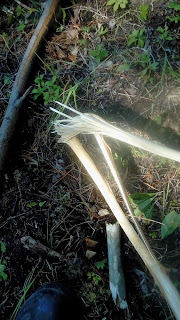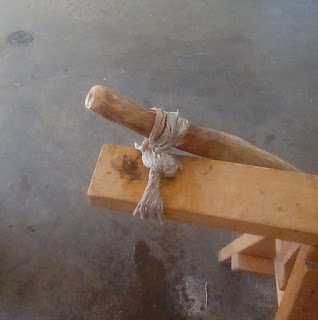Plant and Animal Cord
Learn the braid to make cordage.
Begin by finding an appropriate fiber like a bark that is stringy. I like to use plant or bark that is dead but still in a state that is strong enough to be functional. Using living plants can be avoided and the dead dried material works well.
In the images, I used a branch which had bark that could be easily peeled.
You wont need the outer bark as this will ruin the braid with needless bulk. Peel away the thin inner bark so you have many long strips. I did this by first peeling off the whole bark, inner with tough outer, then further separating the strips lengthwise looking for sections where I could grab a small part of the inner bark and peel it away form the large sections of outer bark.
Make a good pile of thin strips before starting your string.
Instructions for the basic three strand braid can be found anywhere on the net; look it up or play with some string until you get the hang of it.
Using your toes or a wood notch as pictured above, use three long strips (or three separate manageable bundles of fiber), wedge them and begin braiding. Before reaching the end of a given bundle or strip (within two to two and a half inches) add another strip overlapping the ends of fibers and twisting them a bit. Gently begin braiding again while pinching the new fibers into the braid weave and eventually applying some tug to lock them in. The finger work will come with time. Build the integrity by adding more fibers to each bundle as needed. You can finish the cord with a simple knot and begin over using your finished cord as one of three braid strings (to the two other braid components); in this way you randomize the individual additions of fiber to increase over all integrity of the cord. An ideal approach however is to know how many strands are required the first time to achieve the desired cord strength.
Begin by finding an appropriate fiber like a bark that is stringy. I like to use plant or bark that is dead but still in a state that is strong enough to be functional. Using living plants can be avoided and the dead dried material works well.
In the images, I used a branch which had bark that could be easily peeled.
You wont need the outer bark as this will ruin the braid with needless bulk. Peel away the thin inner bark so you have many long strips. I did this by first peeling off the whole bark, inner with tough outer, then further separating the strips lengthwise looking for sections where I could grab a small part of the inner bark and peel it away form the large sections of outer bark.
Make a good pile of thin strips before starting your string.
Instructions for the basic three strand braid can be found anywhere on the net; look it up or play with some string until you get the hang of it.
Using your toes or a wood notch as pictured above, use three long strips (or three separate manageable bundles of fiber), wedge them and begin braiding. Before reaching the end of a given bundle or strip (within two to two and a half inches) add another strip overlapping the ends of fibers and twisting them a bit. Gently begin braiding again while pinching the new fibers into the braid weave and eventually applying some tug to lock them in. The finger work will come with time. Build the integrity by adding more fibers to each bundle as needed. You can finish the cord with a simple knot and begin over using your finished cord as one of three braid strings (to the two other braid components); in this way you randomize the individual additions of fiber to increase over all integrity of the cord. An ideal approach however is to know how many strands are required the first time to achieve the desired cord strength.
Add as much fiber as needed or practical for cord strength. Any material can be used in this manner - sinew, hide, plant fibers. For bow strings, use sinew over hide - the former is made to resist stretching, the latter, not as much. Retain the longest sinew strands. Sinew its incredibly strong, however if small strands (5 inches or so) are used for a bow string, the thicker the cord must be, the more the over all strech it will have, less rugged it will be and freys will appear; these can be awled back into the weave, but this can be difficult and messy. Sometimes though, those small strands are all we have. To make a taugh cord with little stretch, finish the cord, soak it, weave freys into to braid and weight the wet cord down until it dries. Remember the weighting will stretch a wet cord substantially like 4" to a 30" cord.
The longer the sinew strands, the more efficent (ie. fewer individal strands, and fewer joining sections or ends which can frey out) the string will be; it will be thinner, yet support an equal load from a string using shorter sinew strands.
The awl will recognized as an important best friend as this will weave freys back into the cord by opening up the weave and guiding the tips into the weave hole. Weaving is also how my end loops are made using the braid method.
 |
| sinew cord |
The second way to make cord from sinew or plant fiber is to rope it. Start with two strands or two bundles of strands and twist both in the a clockwise direction and then wrap them around each other while holding the twist in the individual strands tight. Continue until the desired length by adding soaked sinew to the ends of the two strands.
I like this medthod for making bow strings. Soak the whole rope when it’s the desired length and again pull taught while you allow it to dry. Use a bucket full of a weight for this or whatever, but make sure the weight does not spin the rope undone if the string is being held taught end to end. The downside of this methode I find is that repairs are more difficult. No awl is used in this type of cord making.
There is no difference in strength between a twisted cord and a braided one.














